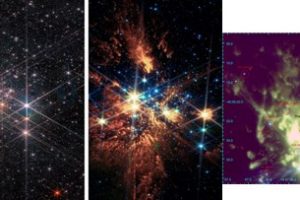A supertelescope for a supercluster. JWST unveils the secrets of Westerlund 1

The star-forming regions can differ significantly from one another, particularly in terms of the population of massive stars (with masses exceeding about 10 solar masses) and stellar density (defined as the number of stars per unit volume). These aspects can vary drastically from one region to another. Such differences are extremely important, as massive stars create environments dominated by high-energy radiation and relativistic particles, while stellar density influences the significance of gravitational interactions among stars in the same region. These parameters have a profound impact on the process of star and planet formation.
Thanks to cutting-edge instruments like the James Webb Space Telescope (JWST), astronomers can now study the processes of star and planet formation in the most energetic environments of the Milky Way: the super star clusters. These rare regions, located at great distances from us, are obscured by dense clouds of interstellar material and reside in highly crowded stellar fields. Despite these challenges, superclusters offer a unique opportunity to deepen our understanding of star and planet formation processes, as well as the early stages of stellar evolution.
The EWOCS project (Extended Westerlund 1 and 2 Open Clusters Survey), led by astrophysicist M. G. Guarcello of INAF – Palermo Astronomical Observatory, aims to study the two super star clusters Westerlund 1 and Westerlund 2. The former is the most massive known young star cluster in the Milky Way, characterized by a unique population of massive stars. Westerlund 2, on the other hand, is less massive but younger. Comparing the two clusters thus allows for an exploration of the timescales of the processes through which these extreme environments influence star and planet formation.
The article “EWOCS-III: JWST observations of the supermassive star cluster Westerlund 1”, the third in the EWOCS series and recently published in Astronomy & Astrophysics, presents JWST observations of Westerlund 1 conducted using the NIRCam and MIRI instruments. The spectacular images reported in the study highlight some of the unique features of Westerlund 1. The NIRCam observations showcase both the massive stars and the hundreds of thousands of low-mass stars in the cluster, including “brown dwarfs,” the smallest stars that can exist, providing invaluable data for understanding how these environments influence the outcomes of the star formation process. On the other hand, the images obtained with MIRI reveal striking nebulosities within the cluster, in the surrounding region, and around the most evolved massive stars. These observations illustrate the complex interactions between the winds generated by the many massive stars in Westerlund 1 during their final evolutionary stages and their impact on the surrounding environment.
The study also involved astronomers V. Almendros Abad, R. Bonito, F. Damiani, L. Prisinzano, and S. Sciortino from INAF – Palermo Astronomical Observatory, as well as C. Argiroffi from the University of Palermo, along with an international team of researchers.
The cover image (click here to view it) shows images of Westerlund 1 obtained with NIRCam (left) and MIRI (right).
Mario Giuseppe Guarcello
Follow MarioSpiegaCose on Instagram () , Facebook (), Youtube (), and X ()
Follow the Astronomical Observatory of Palermo on Facebok and on Instagram
Subscribe the Youtube channel of the Astronomical Observatory of Palermo
